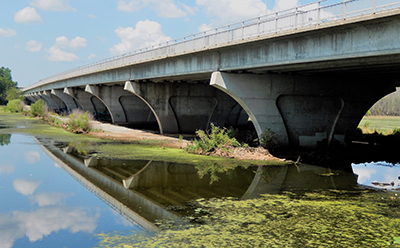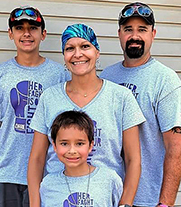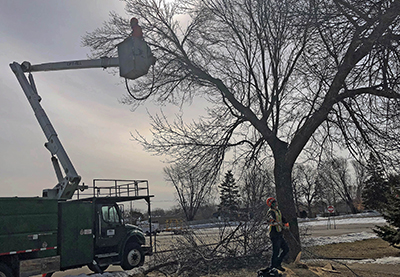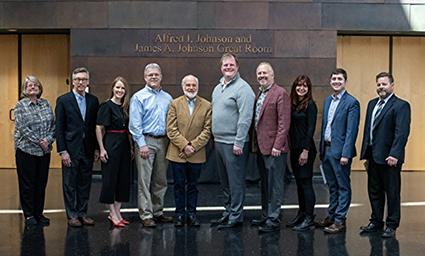 |
|

|
 |
TABLE of CONTENTS
 |
Project profile: Repairs to provide smoother, safer drive on I-494 bridge over Minnesota River |
By Doug Mack

When work is completed, the I-494 bridge Ė shown here prior to project initiation Ė will have a smoother, safer driving surface. Photo courtesy of Metro District |
The Interstate 494 bridge over the Minnesota River in the Metro District connects Bloomington, Mendota Heights and Eagan. It is an essential part of the highway system in the Twin Cities area and has been since it opened 43 years ago. This spring, construction crews began repair work to ensure that the bridge continues to safely transport people and goods.
The overall goals of the $62 million project include repairing pavement, bridge deck, beam ends and railings, replacing highway lighting and bridge joints, and reconstructing the regional trail that parallels the roadway.
Construction crews will work on the center median shoulder this year, shifting traffic on to the outside shoulder, narrowing lanes on the bridge and implementing temporary overnight lane closures.
In 2024, work will continue with resurfacing and repairs on the westbound side of the bridge. This will require road and ramp closures on westbound I-494 between Hwy 77 in Bloomington and Pilot KnobRoad in Eagan/Mendota Heights.
Work on the eastbound side of the bridge will take place in 2025, with road and ramp closures on the nearby eastbound portions of I-494; during this period, the regional trail will also be closed.
When work is complete in 2026, the bridge will have a smoother, safer driving surface and new lighting. The project will also extend the life of the bridge and improve drainage.
Sign up to receive email updates on I-494 bridge project and learn more by visiting the project webpage.
|
| |
|

|
 |
TABLE of CONTENTS
 |
Agency presenters show depth, breadth of work at statewide conference |
By Doug Mack
.jpg)
MnDOTís Mary Schmidt (right) speaks during a panel discussion with contracting partners Marcell Walker of Bolton-Menk and Menaka Mohan of NEOO Partners Inc. Photo by Rich Kemp |
From engineering to sustainability to diversity and equity, the presentation topics at the 2023 Minnesota Transportation Conference & Expo covered virtually every facet of transportation, with MnDOT employees leading many of the conversations.
The annual event, held May 15-17 at RiverCentre in St. Paul, included more than two dozen sessions led by agency employees representing various offices and districts. The presentations and discussions showed off both the breadth and depth of MnDOT’s work, as well as employees’ collaborations with other agencies and organizations, from the University of Minnesota to local governments to nonprofits.
“As a presenter, I especially appreciate that the conference affords us opportunity to work directly with our contracting partners,” said Mary Schmidt, Metro District’s director for advancing equity, who participated in a panel discussion on certified businesses, prime firms and government partnerships. “It’s a collaborative effort to put sessions together, which helps us build relationships of trust while we learn from each other.”
To see the full list of sessions at the event, visit the Minnesota Transportation Conference & Expo website.

In addition to the presentations and panel discussions, the expo portion of the conference offered opportunities to learn about various organizations, products, research and other topics. Photo by Rich Kemp |
|
| |
|

|
 |
TABLE of CONTENTS
 |
Rebecca Neafus, Russell Simon are eligible for Vacation Donation Program |
By Joseph Palmersheim
Two MnDOT employees are eligible to receive donations through the state’s Vacation Donation Program.
Rebecca Neafus, an executive assistant in the Commissioner’s Office, was diagnosed with cancer in January. The six-year MnDOT employee is currently undergoing treatment and has exhausted all sick and vacation leave accruals.
Russell Simon, a transportation generalist with District 7 at the Montgomery truck station, has been a state employee since 2020. Simon’s wife, Carrie, was diagnosed with liposarcoma, a very rare, invasive and aggressive type of cancer. As a result, Carrie is unable to work, and Simon has exhausted his sick and vacation leave accruals.

Russell Simon, his wife, Carrie, and their two sons.
|
The Vacation Donation Program permits any employee who accrues vacation time to donate up to 40 hours of vacation per fiscal year to one or more eligible employees who have exhausted all sick and vacation leave due to a life-threatening disease.
To donate vacation leave:
- Log into Self Service Portal using your employee ID and password
- Select the Benefits tile > My Leave tile. From the menu on the left-hand side, select the arrow to access the Leave Donation
- Select the magnifying glass next to “Reserve Bank” and choose Rebecca Neafus or Russell Simon’s name
- Enter the number of hours you wish to donate
- Select “Save”
- Refer to the Leave Donation Instructions as needed
See Vacation Donation Recipients for all current state employee recipients. |
| |
|

|
 |
TABLE of CONTENTS
|
New reporting tool streamlines diseased tree removal process |
By Joseph Palmersheim

This MnDOT Metro District crew is removing an infested ash tree in the west Twin Cities metro area. A new survey form aims to streamline the process for reporting diseased and damaged trees to MnDOT so they can be removed from right of way areas. Photo by Tim Stevenson |
A new tool is available for city foresters and natural resource managers to report insect- or disease -infested trees within MnDOT’s right of way.
The Community Tree Submittal Survey compiles these community reports into a single, comprehensive database. This helps MnDOT staff notify the correct district maintenance contact, prioritize removals and determine best method for removal.
“In the past, community and city foresters or natural resource specialists have reached out to various people at MnDOT,” said Tina Markeson, roadside vegetation management unit supervisor, Office of Environmental Stewardship. “This new form will help us better manage those requests. Without a combined list of tree removals, it’s difficult to align resources in the most efficient way.”
The new form standardizes information by asking for:
- Location and number of trees
- Species of the tree(s)
- Name of the city forester (or equivalent person)
- Forester’s contact information
The survey is available through a web browser or by downloading an application. Users can submit information in several ways. They can upload pre-existing content using a CSV template or provide location and key details about individual trees.
“Having this survey gives us a better, more systematic way of receiving requests and getting them handled in a timely manner,” Markeson said. “With emerald ash borer attacking so many ash trees in Minnesota, many cities have prioritized removal of infested ash trees. MnDOT wants to be a good neighbor and do our best to remove ash trees along our roadsides in these cities.”
The form is not intended for use by private citizens. Citizens are advised to work with their community's city forester, consultant or Natural Resources staff. Communities can email high-risk tree information directly to MnDOT.
|
| |
|

|
 |
TABLE of CONTENTS
|
MnDOT-funded technology helps keep snowplow drivers safe |
Reprinted from the Center for Transportation Studies

Annette Fritze, University of Minnesota; Bob Johns, former CTS director; Nicole Morris, University of Minnesota; Cory Johnson, MnDOT; Max Donath, University of Minnesota; Brian Davis, University of Minnesota; Jed Falgren, MnDOT; Katelyn Schwieters, University of Minnesota; Gordon Parikh, University of Minnesota; and Nathan Anderson, MnDOT; celebrate the projectís CTS award at the organizationís Annual Meeting and Awards Luncheon on May 1. Photo courtesy University of Minnesota |
During harsh winter weather, snowplow drivers must work in the low-visibility conditions that keep other people off the road. These conditions can make it difficult to center the complex vehicles in the lane and avoid obstacles.
For nearly three decades, a team including staff from MnDOT, the University of Minnesota and Dakota County has worked to improve safety in these situations by developing driver-assist technologies. The system was developed and refined under multiple research projects funded by MnDOT along with other sponsors and partners, such as the Minnesota Local Road Research Board.
Leveraging evolving GPS, radar, and related technologies, the system helps drivers with navigation and alerts them to potential hazards ahead. A display mounted to the dashboard has simple icons to show the truck’s lateral foot-by-foot position within the lane.
The research at the heart of this work recently received the Robert C. Johns Research Partnership Award from the University of Minnesota’s Center for Transportation Studies. The award recognizes transportation projects that include University staff and have generated measured benefits as a result of the impacts of the research.
The work has also already been put into use.
After the completion of research on roads from Minnesota to Alaska, the driver-assist system is used today in MnDOT and Dakota County fleets even as it is being further tested and refined for adoption throughout the state.
A current project nearing completion focused on a two-phase deployment of the system over two winter seasons.
In the first phase, team members integrated and tested the lane guidance and forward-obstacle detection systems and conducted user testing of the display design under different ambient lighting conditions. The Phase 1 system was deployed on three MnDOT snowplows across Minnesota and one Dakota County plow for use during the 2020–2021 winter season. Driver feedback about the system’s performance was collected through usability testing.
In the second phase, the system’s display was redesigned and deployed on eight MnDOT plows and one Dakota County plow to incorporate feedback from the Phase 1 winter season. Changes included replacing the old display with a new LCD panel, redesigning the display to make it easier for the driver to understand, and improving the performance of the forward-obstacle detection system. The system was deployed during the 2021–2022 winter season and driver feedback was again collected through usability testing. Co-investigators were Brian Davis, Chen-Fu Liao, and Nichole Morris, with the work funded by MnDOT and a contribution from Dakota County.
MnDOT’s Shakopee Truck Station was the first to use the equipment and provide feedback to the U team. “One of the first things drivers noticed was that during the day, the lighting system worked great, but at two o’clock in the morning it was way too bright,” says Tim Murphy, the station’s assistant supervisor. Based on the feedback, researchers added a dimmer switch that lets drivers adjust the light intensity. Researchers also made the display smaller so drivers could check the display moving their eyes only.
One example of the system in action occurred during a storm this past January that produced 50 mph winds and whiteout conditions.
“We have pulled trucks off the road temporarily during a shift—drivers are told to pull over if they can’t see,” Murphy says. “But these guys have learned to rely on the system, so when it’s up and running, they say ‘No, I’m just watching the bars according to the U of M machinery.’”
The system helps drivers do their job while making driving less stressful. “I would recommend the system for other drivers and truck stations,” Murphy says. |
 |
|

|
 |
TABLE of CONTENTS
|
Traffic Cam Puzzler #1 |
By Doug Mack
Attention, all puzzle-solvers: Can you name the place pictured below?
This will be a new ongoing feature. In every issue of Newsline, we’ll show you an image from a traffic camera on the 511 website and app, along with a satellite view of the camera’s location, with the road labels removed.
If you think you know where it is, email Newsline editor Doug Mack. The first three people to submit the correct answer will receive the fame and glory of having their names listed in the next issue of Newsline.
|
 |
|
|
|



